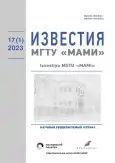Use of a high-efficiency bimetallic recuperator of micro gas turbine units with the power of under 100 kW
- Authors: Chu V.1, Rassokhin V.A.1, Barskov V.V.1, Matveev Y.V.1, Laptev M.A.1, Basati Panah M.1
-
Affiliations:
- Peter the Great St. Petersburg Polytechnic University
- Issue: Vol 17, No 1 (2023)
- Pages: 5-16
- Section: Heat engines
- URL: https://journals.eco-vector.com/2074-0530/article/view/106091
- DOI: https://doi.org/10.17816/2074-0530-106091
- ID: 106091
Cite item
Abstract
BACKGROUND: Modern micro gas turbine units (MGTUs) with the power of dozen of kilowatts are single-shaft and recuperative. Being in the position where improvement of new MGTU cycles is being studied, it is necessary to choose optimal parameters of the MGTU cycle according to the scheme with regeneration when developing such simple units with the aim of ensuring small size and efficiency. Nevertheless, there are several practical restrictions for the development of recuperators, related to the issue of complicated designs together with pressure losses increase caused by regeneration degree increase and to the restriction of materials quality.
AIMS: Study of influence of a recuperator on efficiency of the MGTU, as it is essential for the development of MGTUs.
METHODS: As a part of the study, the overall assessment of the influence of recuperators on parameters of an ordinary Brayton cycle with recuperation is presented in the article. The influence of main parameters, including degree of pressure increase in a compressor, inlet gas temperature and regeneration degree, on MGTU efficiency is considered in depth in the article.
RESULTS: According to the study results, it is revealed that the use of the regeneration degree of over 0,9 with low coefficient of pressure losses in recuperators for the development of modern recuperative MGTUs leads to the unit effective efficiency not exceeding 38…40% because of certain restrictions of gas temperature at the MGTU turbine inlet caused by difficulties with cooling and ensuring small size and efficiency of the unit.
CONCLUSIONS: Use of new heatproof materials is to become an important part of improvement of MGTU in future, therefore it is necessary to study new technical solution when using prospective materials of recuperators for choosing optimal parameters of the MGTU cycle with regeneration. In addition, the option of using bimetallic recuperators is considered.
Full Text
About the authors
V.Ch. Chu
Peter the Great St. Petersburg Polytechnic University
Author for correspondence.
Email: turbotechvn95@gmail.com
ORCID iD: 0000-0001-7029-409X
SPIN-code: 8214-5919
Postgraduate of the Institute of Energy
Russian Federation, Saint PetersburgViktor A. Rassokhin
Peter the Great St. Petersburg Polytechnic University
Email: v-rassokhin@yandex.ru
ORCID iD: 0000-0003-4609-4252
SPIN-code: 3815-2975
Dr. Sci. (Tech.), Professor of the Institute of Energy
Russian Federation, Saint PetersburgViktor V. Barskov
Peter the Great St. Petersburg Polytechnic University
Email: viktorbarskov@mail.ru
ORCID iD: 0000-0001-6914-8212
SPIN-code: 3312-9427
Scopus Author ID: 57220246932
Cand. Sci. (Tech), Associate Professor of the Institute of Energy
Russian Federation, Saint PetersburgYury V. Matveev
Peter the Great St. Petersburg Polytechnic University
Email: matyury@mail.ru
ORCID iD: 0000-0003-3947-2630
SPIN-code: 9918-1199
Cand. Sci. (Tech), Associate Professor of the Institute of Energy
Russian Federation, Saint PetersburgMikhail A. Laptev
Peter the Great St. Petersburg Polytechnic University
Email: mikhail.laptev@outlook.com
ORCID iD: 0000-0001-6045-3288
SPIN-code: 2315-1330
Postgraduate of the Institute of Energy
Russian Federation, Saint PetersburgMehdi Basati Panah
Peter the Great St. Petersburg Polytechnic University
Email: mehdibp.energy@gmail.com
ORCID iD: 0000-0001-5566-8508
SPIN-code: 6388-8007
Postgraduate of the Institute of Energy
Russian Federation, Saint PetersburgReferences
- do Nascimento MAR, de Oliveira Rodrigues L, dos Santos EC, et al. Micro gas turbine engine: A review. In: Benini E. Editor. Progress in Gas Turbine Performance. Rijeka: IntechOpen; 2013:107–141. doi: 10.5772/54444
- Besedin SN. Metodologiya sozdaniya i prakticheskaya realizatsiya mikroturbinnykh ustanovok [dissertation] Saint-Petersburg; 2021. (in Russ). [cited: Apr 04 2022] Available from: http://www.spbstu.ru/dsb/07dc-thesis.pdf
- Xiao G, Yang T, Liu H, et al. Recuperators for micro gas turbines: A review. Applied Energy. 2017;197:83–99. doi: 10.1016/j.apenergy.2017.03.095
- Kostukov AV, Kosach LA, Gornovskii AS. Microturbinewith heat exchanger with regeneration ratio equal 95%. In: Proceedings of the 4th International Conference on Industrial Engineering. Cham: Springer; 2019:2229–2235. doi: 10.1007/978-3-319-95630-5_240
- Arseniev LV, Rassokhin VA, Olennikov SYu, et al. Calculation of the thermal scheme of gas turbines. Tutorial. Saint Petersburg: LGTU; 1992.
- Barskov VV, Besedin SN, Zabelin NA, et al. Calculation of the thermal scheme of a gas turbine plant: a tutorial. Saint Petersburg: Izd-vo Politekhn. un-ta; 2018.
- Rassokhin VA, Homenok LA, Mikhailov VB, et al. Turbine installations. Vol. IV-19. Engineering. Encyclopedia. Editors Frolov KV, et al. Moscow: Mashinostroenie; 2015.
- Aronson KE, Brezgin VI, Brodov YuM. Heat exchangers for technological subsystems of turbine installations. Vol. IV-10. Engineering. Encyclopedia. Editors Frolov KV, et al. Moscow: Innovatsionnoe Mashinostroenie; 2016.
- Barskov VV. The choice of optimal solutions in the design of gas turbine plants of low power. Globalnaya energiya. 2013;4–1(183):244–249. [cited: Apr 04 2022] Available from: https://engtech.spbstu.ru/userfiles/files/articles/2013/4/30_barskov.pdf
- Aronson KE, Blinkov SN, Brezgini VI, et al. Heat exchangers of power plants: tutorial. Ekaterinburg: UrFU; 2015. [cited: Mar 02 2022] Available from: https://openedu.urfu.ru/files/book/
- Arseniev LV, Tyryshkin VG, Bogov IA, et al. Stationary gas turbine installations: a reference book. Liningrad: Mashinostroenie; 1989.
- Aquaro D, Pieve M. High temperature compact heat exchangers: performance of advanced metallic recuperators for power plants. In: Proc. of fifth international conference on enhanced, compact and ultra-compact heat exchangers: science, engineering and technology. September 2005. Hoboken, USA. Hoboken: Engineering Conferences International. [cited: Feb 25 2022] Available from: https://core.ac.uk/download/pdf/185670699.pdf
Supplementary files















